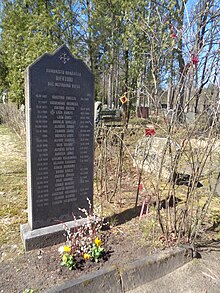Dievturība
This article has multiple issues. Please help improve it or discuss these issues on the talk page. (Learn how and when to remove these messages)
|
| Dievturība | |
|---|---|
| Origin | 1925 |
| Members | ~ 650 (2007) |
| based on 13th century Latvian paganism | |
Dievturība is a Neopagan religious movement which claims to be a modern revival of the folk religion of the Latvians before Christianization in the 13th century. Adherents call themselves Dievturi (singular: Dievturis), literally "Dievs' keepers", "people who live in harmony with Dievs".
The Dievturi movement was founded in 1925 by Ernests Brastiņš. It was forcibly suppressed by Russian Communists in 1940, but later was revived. In 2007, approximately 650 persons were officially active members of Dievturi movement.[1]
History
Dievturība started in 1925 and (as a reconstructionistic movement) is primarily based on Latvian folklore, old folk songs (dainas) and mythology. By necessity, modern Dievturība differs from the historical Latvian religion. For example, there is no evidence that the Latvian pagans recognized a trinity of deities; in Dievturība, Dievs, Māra and Laima are a triune godhead.

Ernests Brastiņš (1892–1942) was the primary force in the early development of Dievturība. He was an artist, an amateur historian, a folklorist and an archaeologist. He documented many ancient Latvian temples and castles, writing the Index of Mythological Notions of Latvian Dainas. Dievturi Catechism is the main inspirational text of Dievturība.
In the 1920s and 1930s the movement attracted several public figures from the cultural sphere, such as the painter Jēkabs Bīne, writers Voldemārs Dambergs, Viktors Eglītis and Juris Kosa, literature historian and critic Alfrēds Goba, and the composers Jānis Norvilis and Artūrs Salaks.[2]
A Dievturība sanctuary, the Lokstenes dievturu svētnīca, was inaugurated on 6 May 2017.[3]
Beliefs
Dievturība is essentially a pantheistic religion. Other deities are either aspects of Dievs (the universe itself, the ultimate reality), or other types of non-deified spirits. In Dievturi theology, several triumvirates of deities and concepts are recognized.
- Gods of fate, the primary triumvirate
- Goddesses of water
Soul complex
- Human form
- velis – astral body
- miesa – physical form
- dvēsele – soul
The difference between the dvēsele (soul) and velis (the astral body) is a fine one. The dvēsele is eternal. It comes from Dievs (god) and will return to him after the death of the miesa. The velis stays near the body, gradually melting and disappearing over time similar to the concept of a ghost or the Greek shade. The end of autumn and the start of winter is accepted as the time of remembrance of dead ancestors. In the dark time of autumn people gave food for their dead relatives due to the "dying of nature" or as a thanks gesture for a good harvest during the summer.
See also
- Baltic religions
- Slavic religions
References
- ^ Reliģisko lietu pārvaldes 2007. gada pārskats "Archived copy". Archived from the original on 2011-07-22. Retrieved 2011-07-22.
{{cite web}}: Unknown parameter|deadurl=ignored (|url-status=suggested) (help)CS1 maint: archived copy as title (link) - ^ Stasulane and Ozoliņš 2017: 238
- ^ Uz salas Daugavā atklāta dievturu svētnīca. 11 May 2017. Skaties.
Resources
- Gatis Ozoliņš. The Latvian Dievturi Movement as Invention of Tradition. In Native Faith and Neo-Pagan Movements in Central and Eastern Europe. Kaarina Aitamurto, Scott Simpson. Acumen Publishing, 2013. ISBN 1844656624
- Anita Stasulane and Gatis Ozoliņš. "Transformations of Neopaganism in Latvia: From Survival to Revival". Open Theology, 3(1), pp. 235-248. Available on-line: https://doi.org/10.1515/opth-2017-0019
External links
- The Ancient Latvian Religion — DIEVTURĪBA - Exhaustive study-paper on the Dievturi movement.
- Latvian Dievturi Church - main organizational body of Dievturība in Latvia.

